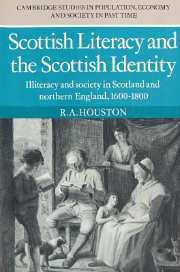 Scottish Literacy and the Scottish Identity
Scottish Literacy and the Scottish Identity Book contents
- Frontmatter
- Contents
- Tables
- Abbreviations
- Preface
- 1 The ideal of Scottish literacy
- 2 Structures and trends in illiteracy in the seventeenth and eighteenth centuries
- 3 Illiteracy in mid seventeenth-century Britain
- 4 The reasons for literacy
- 5 Measures of literacy
- 6 Oral culture and literate culture
- 7 The politics of literacy
- 8 Literacy and the Scottish identity
- Appendices
- Bibligraphy
- Index
2 - Structures and trends in illiteracy in the seventeenth and eighteenth centuries
Published online by Cambridge University Press: 11 November 2009
- Frontmatter
- Contents
- Tables
- Abbreviations
- Preface
- 1 The ideal of Scottish literacy
- 2 Structures and trends in illiteracy in the seventeenth and eighteenth centuries
- 3 Illiteracy in mid seventeenth-century Britain
- 4 The reasons for literacy
- 5 Measures of literacy
- 6 Oral culture and literate culture
- 7 The politics of literacy
- 8 Literacy and the Scottish identity
- Appendices
- Bibligraphy
- Index
Summary
Social dimensions of illiteracy
There are many ways of understanding literacy and there are a variety of ways of measuring it. Traditionally the most common mode of analysis is through a study of the provision of education or the production, ownership and borrowing of books. Unfortunately these tell us little directly about the literate skills of early modern people. They are very much indirect indicators from which we must infer abilities to read and write. The results they produce are necessarily vague about the distribution of literacy in any given population. This is not to say that such measures are without value, for they have advantages when it comes to considering aspects of literacy not directly dealt with by the best available criterion, which is the ability to sign one's name in full on a document. Those who can sign their full name on a document are deemed literate, while people who could only sign their initials or a mark are counted as illiterate. The merits of this measure compared to the indirect ones already mentioned are discussed more fully in chapter 5. It is sufficient to say for the present that the great advantage of signing ability is that it is a universal, standard and direct gauge of literacy. Found in most countries of Europe from the sixteenth and seventeenth centuries onwards, documents which bear signatures or marks allow us to compare literacy in different regions, among different types of people and over time. Generally available, these signatures or marks offer a standard medium for comparison and above all one which involves no problems of inference. Manual skill is being measured directly. There are many ways of understanding
- Type
- Chapter
- Information
- Scottish Literacy and the Scottish IdentityIlliteracy and Society in Scotland and Northern England, 1600–1800, pp. 20 - 83Publisher: Cambridge University PressPrint publication year: 1985
